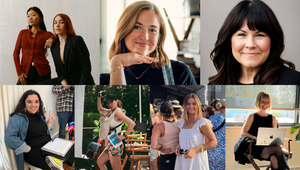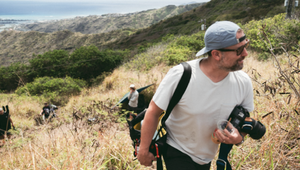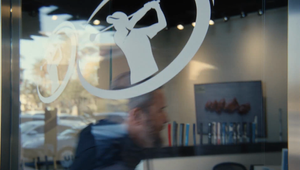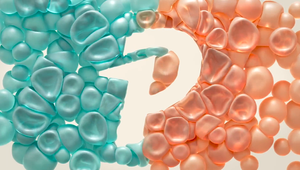
Why Colour Grading Is Not an Isolated Finishing Process

Lennon Mapes is an editor and aspiring colourist at Boston-based creative production studio, VAGRANTS. Having interned at the company while studying media arts production at Emerson College, he became a full-time employee in 2023.
Since then, Lennon combined his experience with skills developed from his freelance photography and filmmaking business, taking on DoP roles for various commercial projects and establishing himself as VAGRANTS’ in-house colourist.
“Editing and manipulating digital images as a form of artistic expression has interested me for as long as I can remember,” he says, explaining that he first taught himself to colour grade because his filmmaking friends needed someone to do it – and weren’t interested in learning the discipline themselves.
He found himself similarly in demand as he carved out a niche in colour upon entering the film industry post-college, and now is the go-to colourist at VAGRANTS, having developed their grading workflow and worked on projects for the likes of Microsoft, Gillette and the Boston Celtics.
Speaking with LBB, Lennon discusses his career journey, the craft of colour grading, and why we’re all in this together.
LBB> When did you decide that being a colourist was a role that you wanted to pursue?
Lennon> After high school, during the pandemic, I focused on the skills and practices I wanted to develop to advance my career in filmmaking. When I moved to Boston and started college, I noticed a lack of interest in colouring among my peers. I saw this as an opportunity to establish myself as the go-to colorist at school. I would offer to colour as many projects as possible throughout my semesters there.
LBB> What was the project that you felt really changed your career?
Lennon> About a year ago, my good friend [cinematographer] Eitan Ehrlich brought up the idea of making a film about his love of biking, athletics and his journey to competing in his first Ironman Triathlon race. A year later, I never expected how impactful this story would be on my life. With the help of [director and producer] William Blackwell Kinney, this film developed into something more than a demonstration of athletic commitment and perseverance, it formed into a beautiful journey of pain, love, and coming to terms with a neurodegenerative disease in Eitan's family.
This commitment to finding a cure for Parkinson's Disease through the New England Parkinson's Ride and The Michael J. Fox Foundation for Parkinson's Research took us all the way out to Oceanside, CA where Eitan competed in his first-ever Ironman 70.3 race. Within Eitan’s family and throughout the film, a consistent mindset we had was finding the positives in complex and challenging situations. Every day I ride my bike to work I think about the positive ways my work can impact like-minded creatives and the community around me, and how to focus on what works well to improve my position further.
LBB> How did you hone your craft, and did you have any particular mentors?
Lennon> All my knowledge of colour grading comes from self-education using online resources, extensive practice and trial and error – not from formal schooling. Some of those online educators include Cullen Kelly and Darren Mostyn. For every project, I collaborate with individuals who have unique visual preferences, which I blend with my colouring techniques to create a final result that exceeds their expectations. Each project presents new challenges that demand creative solutions.
Every day, I continue to develop my colouring intuition and my collection of technical knowledge and tools to help get the job done. To be more intentional and informed about my decisions and the creative process, I created a workflow that goes over every step of my technical practice and explains why I use specific tools. This keeps me accountable for navigating new situations no matter how familiar I am with the issue at hand.
LBB> Tell us a bit more about that creative process!
Lennon> Developing a look starts way before the cameras start rolling. Connecting with the director, art and wardrobe department, and DP to establish a cohesive and intentional colour palette for the project is critical for success in the colour suite. After the shoot, receiving references (especially ones with skin tones) that closely represent the footage is extremely helpful for setting the colour in the right direction.
Understanding the visual tone of the scene and the juxtaposition of light and dark, saturated and dull, or the emotional elements of the music and script all fill the puzzle pieces of a nearly complete project that needs colour grading as its final piece. Colour grading is not an isolated finishing process; it's a hands-on undertaking from start to finish, with every aspect of the film ingrained in the final look.
LBB> When you’re not in the colour suite, what inspires you?
Lennon> In my opinion, nature stands as the world's finest colourist. No digital signal rivals the breathtakingly authentic and emotionally captivating scenes created by the natural world. From the azure skies and dramatic mountain vistas of the Rockies to the terracotta rooftops and turquoise waters of the Mediterranean, and the verdant, lavender-tinged hills of New England.
But, as time goes on and cameras begin to capture dynamic range closer to the human eye, colourists get to tinker and adjust with an even larger palette of colours to our stylistic liking and create our unique blend for each project, further expanding our ability to manipulate and refine our look. Therefore, for me, nature is one of the most influential and inspirational aspects of my work.
LBB> How do you ensure that each colourist-director partnership is a success?
Lennon> The basis of a successful partnership between a colourist and a director lies in establishing clear communication and expectations right from the start of the creative process. This involves a detailed discussion about the visual style desired for the project. Is it commercial clean, is it filmic and pushed, or somewhere in between? By establishing a shared understanding of the visual style early on, the colourist and director can work together more effectively to achieve a cohesive and impactful final result.
LBB> What advice would you give to budding colourists?
Lennon> Learn every tool at your disposal, don't overcomplicate simple tasks, and be purposeful with every adjustment you make – even if the purpose is experimental. Learning about each tool – its behaviour, effects, and when and why to use it – is critical. Having a solid technical foundation will save you from massive headaches down the road. Experiment with new techniques and find what works best for you.
As I mentioned earlier, I created my own workflow to document these practices. This helps to keep a clear understanding of the what, how and why of the technicalities of colour grading.
LBB> How is the craft and trade of colour grading changing?
Lennon> I could go on about the latest and greatest tools from Blackmagic or Adobe for AI assistance and automation, but from the perspective of an early-career colourist, the advent of AI video creation, if widely implemented, will not provide selective employment safeguards for anyone within the post-production pipeline. It is not likely one would prompt AI to generate a flat video file in the ARRI log colour space, specifically to maintain the relevance of a colourist later in the finishing process.
The widespread adoption of AI video generation will displace all roles within the industry. So long as it is cheaper to create forms of advertising with AI, that will be the way forward for the foreseeable future until something new and more economically viable comes along. I strongly believe the only forms of real-world video production that will survive longer than others are documentaries. So to answer this question, colour grading will change as much as an editor, producer, director and DPs job will in the next 10 years. We’re all in this together.
To see Lennon's colour reel and read more about VAGRANTS, click here.















